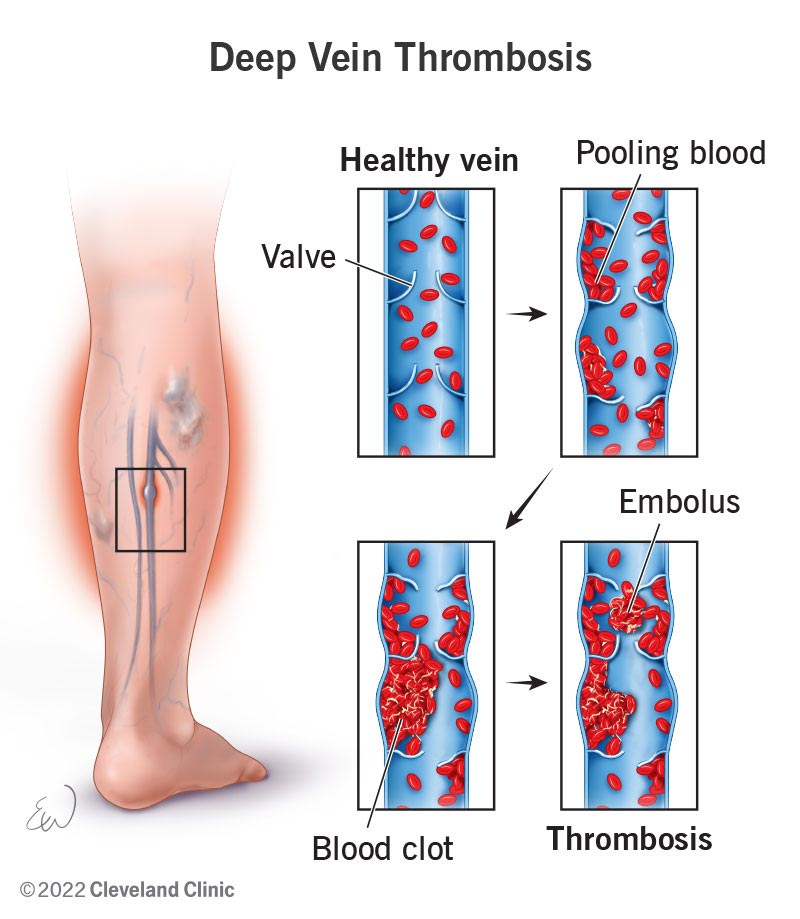Venous thrombosis refers to the formation of a blood clot (thrombus) within a vein. This condition can obstruct normal blood flow, leading to swelling, pain, and in severe cases, life-threatening complications such as pulmonary embolism (PE). The most common type is deep vein thrombosis (DVT), usually affecting the deep veins of the legs.

Pathophysiology of Venous Thrombosis
Venous thrombosis typically results from one or more elements of Virchow’s Triad:
- Endothelial Injury – Damage to the inner lining of the vein.
- Venous Stasis – Slow or stagnant blood flow.
- Hypercoagulability – Increased tendency of the blood to clot.
These factors can act independently or synergistically to initiate thrombus formation.
Types of Venous Thrombosis
Deep Vein Thrombosis (DVT)
Occurs in deep veins, especially in the lower limbs. It may be asymptomatic or present with leg pain, swelling, redness, and warmth.
Superficial Vein Thrombosis
Involves veins closer to the skin surface. Less dangerous than DVT but can progress to deeper veins.
Pulmonary Embolism (PE)
A serious complication where a dislodged clot travels to the lungs, causing respiratory distress or even sudden death.
Risk Factors for Venous Thrombosis
Several factors increase the risk of developing venous thrombosis:
- Immobility or prolonged sitting (e.g., travel, hospitalization)
- Surgery and trauma
- Cancer and chemotherapy
- Pregnancy and postpartum period
- Hormonal therapies (oral contraceptives, HRT)
- Inherited clotting disorders (e.g., Factor V Leiden)
- Obesity and smoking
- Advanced age
- History of prior DVT or PE
Signs and Symptoms
Venous thrombosis can vary in presentation based on the location and severity of the clot.
Symptoms of DVT
- Swelling in the affected limb
- Pain or tenderness, often in the calf
- Skin discoloration or redness
- Warmth in the area
Symptoms of PE
- Sudden shortness of breath
- Chest pain that may worsen with deep breaths
- Rapid heart rate
- Coughing, sometimes with blood
- Lightheadedness or fainting
Diagnostic Approaches
Timely diagnosis is critical for preventing complications. Several diagnostic methods are employed:
D-dimer Test
A blood test that detects clot degradation products; high sensitivity but low specificity.
Compression Ultrasonography
Primary imaging tool for diagnosing DVT; non-invasive and widely available.
Venography
Contrast-based imaging used when ultrasound is inconclusive.
CT Pulmonary Angiography (CTPA)
Gold standard for detecting pulmonary embolism.
MRI and Doppler Ultrasound
Used for specific anatomical locations or in pregnancy.
Treatment and Management
The goals of treatment are to prevent clot extension, recurrence, and embolization.
Anticoagulant Therapy
- Initial treatment: Low Molecular Weight Heparin (LMWH), Fondaparinux, or Unfractionated Heparin
- Long-term: Direct oral anticoagulants (DOACs), Warfarin with INR monitoring
Thrombolytic Therapy
Used selectively in cases of massive DVT or PE with hemodynamic compromise.
Inferior Vena Cava (IVC) Filter
Implanted to prevent emboli from reaching the lungs, typically in patients with contraindications to anticoagulation.
Surgical Thrombectomy
Reserved for severe cases with limb-threatening ischemia.
Preventive Strategies
For High-Risk Individuals
- Prophylactic anticoagulation during hospitalization or post-surgery
- Use of graduated compression stockings
- Pneumatic compression devices
Lifestyle Modifications
- Maintain mobility and hydration
- Avoid prolonged immobility
- Smoking cessation
- Weight management
Complications of Venous Thrombosis
If left untreated or inadequately managed, venous thrombosis can lead to:
- Pulmonary Embolism – A life-threatening condition
- Post-thrombotic Syndrome – Chronic leg pain and swelling
- Recurrent DVT or PE
- Chronic Thromboembolic Pulmonary Hypertension (CTEPH)
Special Considerations
Pregnancy
Increased risk due to hormonal changes and pressure from the gravid uterus. LMWH is preferred due to safety.
Cancer
Malignancies and chemotherapy heighten thrombotic risk. LMWH or DOACs are standard options.
Genetic Testing
Considered for young patients with unprovoked thrombosis or a family history.
Prognosis and Long-Term Outlook
With prompt diagnosis and adequate treatment, the prognosis is generally favorable. However, recurrence rates remain significant, necessitating vigilant follow-up and adherence to preventive measures.
Venous thrombosis is a serious medical condition with potentially life-threatening consequences. Awareness of risk factors, early recognition of symptoms, and timely intervention are key to reducing morbidity and mortality. Implementing preventive strategies and individualized treatment protocols can significantly improve patient outcomes.